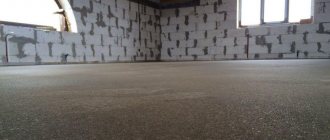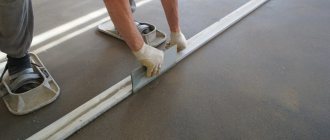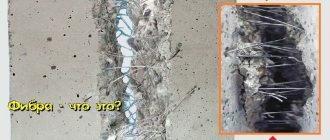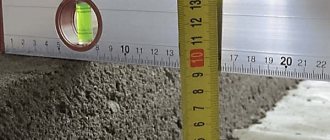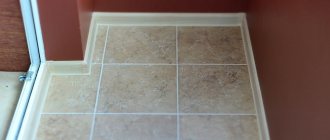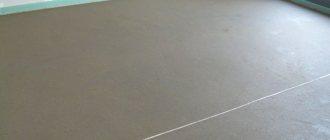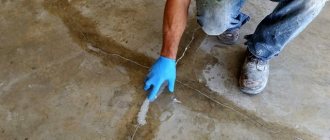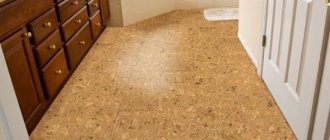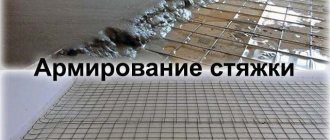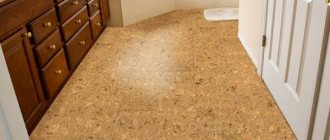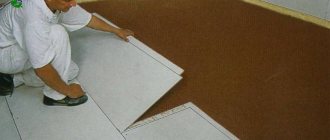In this article we will look at the basic methods of creating a perfectly flat floor in an apartment. Preparatory and key stages are presented. I will explain which materials are most effective.
If you need to renovate your apartment with high quality and in a modern way, then you cannot do without replacing the flooring. In terms of price it is more profitable. And the appearance of the new coating is quite attractive.
Have questions ? Call!
Don't start renovating until you read this.
What floor to install in an apartment Warm floor in an apartment: a modern choice How to change floors in Khrushchev, Stalin, Brezhnevka
A perfectly flat floor - why is it needed?
Even in a new building, there are differences in the floors. They can reach 10 cm. Today, panel slabs are laid so that the ceiling between floors with its smooth surface is directed towards the ceiling, and its lumpy surface towards the floor. And on this side, without screeds, you can only lay linoleum. The parquet will be constantly deformed.
Thus, we fill the floor according to two main reasons:
- Laying flooring.
- Construction of a floor with water or electric heating.
- Other floor insulation.
For your information
To get a perfectly even coating, we use cement filling. This operation is also called screeding. It is necessary before laying the topcoat. In this regard, many owners have a question about how to properly fill the floors in the apartment. This technology is not anything overly complicated. The main thing is to perform all operations correctly and step by step.
Traditional screed mortars
Before the advent of dry construction mixtures on the market, floor screed was usually made with cement-sand mortar. The process began with the purchase of the required amount of cement and sand, labor-intensive mixing of ingredients in the required proportions, and pouring the floor according to the beacons. Budget option, hard work, fairly durable floor and not very high quality surface. No matter how you level the cement-sand mixture, sagging and unevenness will still remain. In addition, the finished screed always shrinks, which results in the formation of small cracks. No laminate will want to lie flat on such a floor.
Another option, more expensive: ready-mixed concrete, ordered at the factory and delivered by concrete mixer truck. The process is greatly simplified; the mixture is ready and delivered directly to the work site. Self-leveling concrete floors are traditionally considered an excellent base for any coating; they have high strength and low thermal conductivity. The disadvantage of this method is its high cost; renting a machine for transporting concrete and a concrete pump for supplying it is a rather expensive undertaking. In addition, concrete screeds require the mandatory installation of a finishing layer; without it, their operation is only possible in open areas and in utility rooms.
Mortars for perfect pouring - building mixtures or concrete? Choice
In modern conditions, pouring a floor screed with your own hands is quite feasible. And there is a large assortment of various Russian and foreign levelers on sale. These are innovative tools.
Their main specificity is that they are poured without much work with beacons and guides.
We breed them competently, using strict technology. They are affected by gravity and tension. And they are evenly distributed over the entire working surface. Cover all uneven areas and bumps. This is the easiest way to fill the floors to obtain an even, seamless and shiny finish.
There is also a classic - the use of cement compositions. They cost less. But the filling technology is more complicated. What to choose and how to fill the floors in the premises, each owner decides for himself, based on his budget, goals and scope of work.
Marking stage. Installation of beacons
What are lighthouses? These are rigid metal guides necessary for marking and leveling the floor screed. Setting them up correctly is the key task of the first stage.
Installation of beacons
Beacons are installed using a special tool - a level (laser builder), but such a tool is usually used by professional construction teams. Amateurs can get by with a simple rack level, which will also give a satisfactory result, although not as accurate as a level. In addition to a simple level, you can also use a water level to set the beacons. Using this level, marks are made in the corners at the level of a meter, which are later transferred using a tape measure to the required screed height. This makes it easier to orient the beacons located along the edges.
Using a level, you need to place the second beacon. You need to install it this way:
- mix the cement and scatter it in slides in a line along one of the walls at a distance of two hundred to three hundred mm from it;
- press the first beacon into the hill so that its height is in the range from 30 to 50 cm from the floor level;
- The second beacon is more difficult to install - it is necessary that it correspond in height to the first beacon (which is regulated by the level) and be located at a distance from the first one slightly less than the length of the rule with which you are going to make the screed.
Then the remaining beacons are installed in the same way.
self-leveling floor screed
Installation of beacons throughout the area
After installing the beacons in cement slides, you need to give the structures time to dry so that you cannot accidentally knock them down while laying the screed. Most often, the installed beacons are left overnight, and further work begins the next day.
Preparation steps before making a poured floor
For preparatory and main work we use the following arsenal:
- Reiki. They are necessary for beacons.
- Metal brush.
- Container for working personnel.
- Roller for priming.
- Sidewalk scraper.
- A small brush for applying primer to hard-to-reach or small areas.
- Putty knife.
- Needle type roller.
- Drill with a nozzle for mixing the solution.
- Primer.
You can fill the floors in your apartment correctly if you act strictly step by step. And the stages of work are as follows:
- Surface preparation. Removing old coating, cleaning from dust and dirt.
- Padding.
- Waterproofing.
- Thermal insulation.
- Checking horizontality.
Next comes the screed itself. Then we wait for the surface to dry and lay the base coating.
Have questions ? Call!
Stage 1. Preparing the space
Preparing the space
The surface must be cleaned of debris, dust, paint residues, grease stains and previous coating. You can use a special construction vacuum cleaner, but if you don’t have one, then an ordinary one will do, which is not too bad. Only it needs to be cleared of garbage more often! By the way, wet cleaning will not be superfluous.
This is a very important stage, because contaminant particles prevent the floor surface from adhering to the fill. Voids appear in it, from which cracks will subsequently appear, and as a result, the incorrect screed will collapse on its own and lead to damage to the selected coating.
Preparing the base - leveling and waterproofing
It is necessary to fill the floors in the apartment step by step. This is the most important condition for obtaining the proper result.
The first step is preparing the base. We remove the old coating. We carry out a thorough cleaning. We eliminate dust and dirt. We use a vacuum cleaner. Degrease the surface with a simple soap mixture.
If you need to fill the floor in a room that does not have a threshold, we create one. For this we use slats. This prevents the leveling agent from leaking into adjacent rooms.
Important
Before the pouring process, it is important to remove outdated baseboards. And we must glue the wall-floor joints. There is a good tool for this - damper tape.
Next, the floor in the room is covered with a primer. Thanks to it, the floor adheres better to the base. Apply at least two layers of primer. Apply the second layer only after the first layer has completely dried. Priming continues while it is still absorbed by the base.
.
The primer enhances the strength of the surface and its adhesion to future materials.
When we work with classics (concrete-sand composition), we use a universal primer. In rooms of modest size, we apply it with a brush. In large rooms - a roller.
Before starting other work, the primer dries for about two hours.
The main work starts one day after this operation.
At this stage the level. We walk around the room with him. And we make horizontal marks on the walls. We will rely on them during the pouring process.
Technology: steps and instructions, materials, meshes
When installing a concrete floor, it is necessary to carefully study the technology of this process. In this section we will look in detail at the materials that will be needed and the stages of work. Let's consider step by step all the aspects of constructing concrete floors.
Waterproofing concrete floors
- The first stage after preparing the old coating or sand bed is waterproofing the floors. This is a very important part of the work, since its result determines whether moisture will penetrate into the room, thereby causing the appearance of fungus, which is dangerous to human health and destructive to the floors themselves.
- Waterproofing is made from rolled bitumen or polymer materials; sometimes a fairly thick polyethylene film is used.
- Waterproofing materials are laid over the entire floor area with an overlap and then secured with construction tape. The coating must be continuous, without damage. It should be placed on the walls - approximately 20-25 cm in order to protect the joints between the wall and the floor from moisture. After laying the last, finishing layer of the floor, the excess exposed parts of the waterproofing are cut off.
- Waterproofing can also be done on a rough concrete layer, in which case you will have to resort to the method of coating with insulating materials.
How and what formwork is made of
The next stage is the installation of formwork. It is installed if the area of the room is large and it cannot be concreted in one day.
The formwork is made of boards 2-2.5 cm thick along the entire perimeter of the room. It divides the floor area into squares, the size of which depends on the speed of work during the day. Those. if it is impossible to fill the entire area of the room in one day, this is done in squares.
Mesh for floor reinforcement
The next step is the installation of reinforcement for concreting. Strengthening floors with reinforcement is usually used in cases where they are expected to bear a large load. The choice of type of fittings also depends on the purpose of the room. Basically, for the strength of floors, road mesh is used, the diameter of the rods is 0.5 cm.
If a very large load is planned on the floors, a metal rod with a thickness of 10 to 16 mm is used together with the reinforcing mesh; it is mounted directly on site. Metal fiber can also be added - this is metal fiber that is mixed with the concrete mass.
Concrete laying
Having completed all the preparatory work, it is necessary to proceed directly to concreting the floors. If this process is carried out at an industrial enterprise and large areas are covered, the best option is for the concrete to be supplied into the formwork uninterruptedly by a concrete mixer, possibly even using a concrete pump.
- At the first stage of pouring concrete, cement grade M500 or higher is used for the solution, mixed with marble or granite chips; it is also good to add a hardener or plasticizer to this layer of concrete.
- Next, the mixture is leveled using a vibrating screed along the beacons. If the areas are large, a deep vibrator is used.
- Beacons are displayed as follows:
- half the volume of the required level is filled with concrete mixture, and hills are formed on it - these will be the beacons along which the main surface will be leveled;
- on top of the beacons you need to place a rail with a mark, which is aligned on the line of the level established by leveling;
- the top of the beacons is adjusted to the bottom of the rail;
- beacons should be placed no further than two meters from each other.
- When using a vibrating screed for leveling, it is necessary to set the guides at the zero level before starting work. Then a vibrating screed is installed on them. It is pulled along the guides on top of the concrete mortar laid 2-2.5 cm above their level, leveling and compacting the concrete.
- If there is a need for the concrete screed to harden faster, but not lose its strength, it makes sense to use concrete vacuuming. This is done as follows:
- when the leveling stage is completed, filter material is laid out on the concrete and covered with an airtight mat on top;
- A vacuum pump is connected to the nozzle in the center of the mat; it will draw off excess moisture without damaging the quality of the concrete.
Grouting work
When the laying of concrete is completed and the surface is leveled, it is necessary to give it time to harden. If the vacuum method was used, the time for the desired hardening will be about seven hours. The concrete should harden to such a state that, stepping on its surface, the foot will leave a mark 3-4 mm deep.
The concrete begins to be grouted with coarse grout from those places where it first hardens (these are wall areas and door openings), and only then all remaining floors are grouted. It is good to use a topping for grouting - it is a concrete hardener. It is scattered on the surface and grouted until the mixture is completely combined with the concrete. After rough grouting? of the entire topping, a second rough grout is immediately performed. The last floor grouting is done when, when stepping on the concrete, a mark 1 mm deep remains. The grout should be applied as follows:
- if light loads are planned on the surface of the screed, three to five kilograms of topping per 1 m2 is sufficient;
- for medium and heavy loads - five to eight kilograms per 1 m2;
- colored floors also require five to eight kilograms per 1 m².
How to concrete a floor with your own hands - watch the video
Watch this video to learn in two minutes how to concrete the floor in your house yourself:
Types of seams and their cutting
There are the following types of expansion joints when installing screeds:
- to isolate the floors from the walls of the building, insulation joints are made to protect the screed from deformation of the walls;
- to protect the screed from the appearance of cracks during the hardening of the solution - shrinkage joints;
- When dividing floors into squares with formwork, construction seams appear at the points of their contact; slats are used for them, laid in the middle of the depth of the concrete screed, across the seams.
The seam is cut to one third of the thickness of the screed.
Sealing work
Sealing the seams is necessary to protect them from moisture, which can begin to destroy the entire floor structure under a certain load on them. In industrial buildings, PU-40 emphymastic is used for sealing; it gives the seam elasticity and allows it to withstand loads. Before sealing, the seam must be cleaned of dirt and dust by blowing.
Concrete floor reinforcement
How to fill the floor in an apartment with a reinforced screed? This issue is especially relevant when working on the ground. His solution is the use of reinforcement. We use one of these options:
- Special steel mesh.
- Fibrin. It is fibrous plastic or metal. We add it to the working solution.
At the reinforcement stage, we install wiring and install heating technologies.
Nuances of floor structure reinforcement
We reinforce the concrete floor in the house so that the structure receives powerful protection from mechanical stress and strong vibrations. This also significantly increases the service life of the floor.
Motives for floor reinforcement:
- Laying a floating screed according to the project.
- Construction of a floor on the ground.
- Compliance with certain building regulations in underfloor heating technologies.
- The floor is used for industrial purposes and is subject to enormous loads.
- The height of the concrete layer exceeds 5 cm.
If the floor structures are subject to serious loads, we give preference to metal reinforcement.
The rod diameter is affected by operating conditions and loads. Usually it is 0.6 - 1.2 cm. Cell parameters: 1 x 1 x 2 x 2 cm.
To fasten the mesh we use welding or binding wire. We often use ready-made meshes in our work. They are based on VR-1 wire and d 2-6 mm. The cell parameters are in the range 5 x 5 - 2 x 2 cm.
When reinforcing using this method, we fill the floor in the apartment in stages and follow the following order:
- The position of the mesh is in the very thickness of the concrete. This way the steel is protected from corrosion.
- Thoroughly clean the base from debris and dirt.
- Repairing cracks (if any). Their dust removal. Padding.
- Priming the base in 2-3 cycles.
- Waterproofing and sound insulation are installed.
- Marking is made and a level is applied.
- The mesh is placed on stands. This is how the material ends up in the thick of the concrete. We keep the overlap in one cell.
- Connecting butt sections using tying wire.
- Beacons are attached to the reinforcing layer. This cannot be done without metal U-like profiles.
- The train is placed between the lighthouses. It is leveled by the rule.
- After the concrete has cured, the guides are removed. The existing voids are filled with the mixture.
- A protective film is spread over the screed. Lasts 5-7 days.
For your information
We use fiber material for surfaces located in alkaline environments, where temperature parameters do not exceed 200 degrees.
You might be interested
What floor to install in an apartment Warm floor in an apartment: a modern choice How to change floors in Khrushchev, Stalin, Brezhnevka
Floor on joists
When it is necessary to create a reliable base for a wooden covering and the load on the floor cannot be significantly increased, logs or (much less often) so-called modular raised floors are used. These structures make it possible to eliminate any unevenness in the ceiling, but with a significant additional loss of ceiling height - at least 50 mm (the minimum intrinsic thickness of the structure).
The easiest way to make logs is from high-grade coniferous timber and level them using plastic wedges. Aluminum products on adjustable screw supports will cost several times more.
Vladimir Grigoriev/Burda MediaWhen assembling the base on joists, the horizontal can be set using a bubble level.
Vladimir Grigoriev/Burda Media
The joists are attached to the ceiling with dowel nails.
Vladimir Grigoriev/Burda Media
Plywood to the joists using ordinary self-tapping screws.
The tongue-and-groove floorboard is attached directly to the joists (with this design, their cross-section must be at least 50 × 50 mm), and the parquet and parquet boards are attached to plywood flooring with a thickness of 16 mm or more. It is advisable to fill the space between the joists with expanded clay, mineral wool or soft wood-fiber boards - this will improve heat and sound insulation.
Creation of formwork. Working with Guides
We lay the concrete floor in parts - cards. These are rectangular areas. Their parameters are determined by two factors:
- Total surface area.
- Possibility of filling the composition in one working cycle.
We place formwork along the perimeter of these areas to mark the finished floor. It is created from a 5 x 10 cm board. We pre-drill holes in the boards for reinforcing pins with a distance of 50 cm. We apply the formwork lines to the seam pattern.
We fill the floor in a new house along the guides. We can use them as:
- metal profiles,
- steel corners 5 x 5 x 0.3 cm,
- profile pipe 4 x 2 x 0.2 cm.
We mount the guides by welding to reinforcement posts with a diameter of 1.2 cm. To control the evenness, we use an optical level.
All areas where the surface is adjacent to the load-bearing components are covered with Izolon with a density of 4 mm. This is a damper tape based on polyethylene foam.
So we fill the floor in parts. Just before filling, we treat all profiles with engine oil. And we moisten the rough base with water.
Have questions ? Call!
Screed reinforcement stage
The function of reinforcement is reliability. To prevent cracks from forming in the floor over time, through which moisture will penetrate (if we are talking about a private house), a reinforcement mesh is needed. This mesh is attached with dowels to the concrete base slab. It is best to also organize a protective layer, for example, from pebbles, so that the mesh does not adhere closely to the slab.
Reinforcement is carried out in most cases using a special metal mesh: the cell of such a mesh should be 10 by 10 or 15 by 15 cm in size, and the wire thickness should be at least 3 mm.
Plastic or glass mesh for screed reinforcement
However, recently, reinforcement using meshes made of composite materials has become increasingly popular. For example, a plastic mesh does not decompose when exposed to moisture, and this is not its only advantage: it is also quite lightweight and easy to use and does not block access to the wireless Internet, which is what Wi-Fi users often complain about. In addition, the plastic mesh is non-conductive, which is quite important if the work is performed by a non-professional - you can feel absolutely safe and not be afraid of getting injured.
Polypropylene fiber
Dispersion reinforcement using fiber, which includes glass, steel and other components, is also used. Dispersion reinforcement is not considered complete and is used as a supplement to broaching reinforcement, allowing concrete to mature much faster and eliminating the appearance of unevenness.
Laying waterproofing
How to fill the floor in an apartment yourself if there are significant gaps in the base? The areas where walls meet floors are considered particularly vulnerable. Areas near communications are also considered weak. Here we lay waterproofing.
To do this, we use the following types of water protection:
- Films and rolls. These are the most common types. These are polymer membranes consisting of many layers. They also have thermal insulating properties.
- Liquid. These are great pore filling products. It turns out a thin water-repellent film
- Mastics. These are adhesive plaster mixtures. Their bases are polymers, resins, liquid rubber. The mastic forms a powerful waterproof layer.
- Powders. They use plasticizers and binders. They need to be diluted with water according to the instructions.
Surface level and placement of beacons
Many owners are interested in how to fill the floor in an apartment efficiently and evenly? To do this, be sure to determine the level of the screed and install beacons (special slats).
Using a level, check the evenness of the base. We indicate the level of the intended coverage on the walls.
From plastered areas, remove the plaster 0.25 cm above this line. Using these notations we identify the highest point of the surface. This is a guarantee of proper filling.
Here the working algorithm is:
- We measure 1 m up the wall, counting from the door threshold. We draw a line.
- We draw a line around the perimeter of the room. We maintain its parallelism using a level.
- The second parallel is drawn at a distance of 1 m under the control symbol.
- We drive nails into the corners of the room on the bottom line and stretch the wire.
Thanks to the marks on the load-bearing components, it is easier to place beacons in a new apartment. The distances between beacons correspond to the length of the rule. We apply the rule to level the mixture.
The final result depends on the placement of the slats. After all the work, the slats are removed. They leave recesses that can easily be filled with the same solution that was used for the screed.
With guidelines it is much easier to fill the screed. And so we get the necessary flat surface. We install beacons even for work on a small area.
Bedding question
Before you make the working composition and pour it onto the required area, you need to make a bedding. This is the so-called pillow. It consists of three layers.
- The initial one is gravel. Density: 5 -10 cm. Water it with water and tamp it down. To control the thickness of the layer, be sure to drive pegs directly into the soil. We put them by level. Having slept and compacted this layer, we take them out.
- The second one is sandy. Density -10 cm. We also adjust the thickness with pegs. We water the sand and compact it using a vibrating plate.
- Shchebnevy. Thickness – 10 cm. We carefully level it and make it denser. There should be no sharp edges on the surface. Suitable crushed stone has a fraction of 4-5 cm. After compaction, sprinkle it a little with sand and tamp it again.
Horizontal level adjustable
Video guide for installing beacons
Pouring concrete
To fill, you will need a rule and a trowel. It is advisable that the concrete mixer be located in the same room where the work is being done. It is on wheels and can be moved to free space as needed.
Preparation of mortar for screed
Step 1. Unload the concrete onto the floor and spread it with a shovel between the two beacons. Start from the wall, don’t rush, add a layer of approximately the same thickness.
Step 2. Make a rough edit with a trowel. Level out the recesses and throw away excess mass on the back side of the lighthouse. Do not throw the mixture too widely, do not forget that the reinforcing mesh must be constantly raised; it may fall during work.
Adding mortar with a trowel
Step 3. Level the poured concrete properly. The rule needs to be pulled towards you and simultaneously moved left/right.
Alignment
Practical advice! If it is difficult for you to work in a bent position, then work on your knees. To avoid injury, place a flat board under your knees. As the space between the beacons fills, move the board.
There should be a strict rule for leveling concrete. The mass is heavy, you usually need to pull with great effort. If the strength of the device is insufficient, then it will bend in the middle. As a result, a gutter forms between the beacons, and this is a very unpleasant marriage. Constantly clear the beacons of stones; the width of the poured concrete should be such that it can be leveled with outstretched arms.
Another photo of the process
Step 4. Using the same principle, screed the entire room. Do not forget to manually throw and level various small niches and places where walls meet the floor.
After the floor has completely dried, we can begin further refining the floor surface.
Work should always start from the farthest wall and move towards the exit of the room. Pull the concrete mixer behind you as needed. Constantly pay attention to the position of the reinforcing mesh. There are times when all the special measures to raise it do not give the desired effect. If so, after leveling each small section of concrete, lift the mesh again. Remember that it should never lie on the base.
How to make a concrete screed with a slope - the beginning
How to make a concrete screed with a slope - continued
How to make an insulated concrete screed
Mechanized floor pouring
Creation of the working staff
This composition is not difficult to create. We dilute it in water strictly according to the instructions. Mix using a drill with a special attachment. This way we get a homogeneous composition.
A simple recipe for preparing a sand-cement mixture is as follows:
- 4 shares of perlite are used. Pour 2 parts of water on them.
- Add water and cement one part at a time to the solution. Mix.
- Add two parts of sand and 10 parts of water.
- Mix the mixture until it reaches a plastic consistency.
This option is good for use in a new private home. It is also often used on the lower floors of buildings with many floors. In an apartment it is also justified if a small layer of fill is created.
Pouring process
How to fill the surface of an existing base more efficiently? If all measures for leveling have already been provided, then the process should be completed in one day. This is the key to uniform composition.
Filling begins from the far corner of the room. To level the layer, apply the rule. We evenly distribute the material within the boundaries of the fixed beacons.
Using a needle roller, remove air from the mixture. This way we exclude the occurrence of internal voids in it. Then we level the screed completely. We repeat the operations until the base is completely filled.
If you have some misunderstandings, you can watch a video of how to pour a floor screed with your own hands.
Stage of pouring the floor screed
Stage of pouring the floor screed
- The mixed solution must be poured between the beacons and carefully leveled with a shovel. The solution should be poured just above the construction beacons. Next, you need to use the rule - this tool must be placed between the beacons and pulled towards you with quick translational movements.
- It is unlikely that it will be possible to level the solution in one approach - you need to perform the operation two or three times.
- After the first portion of the screed is poured, it is necessary to proceed to the second portion. So, portion by portion, the entire floor will be flooded.
- It is necessary to fill the screed within one day, otherwise the coating may crack.
- It is worth noting that damper tape is usually placed at the lower edges of the walls to compensate for expansion. The material for such a tape is foamed polyethylene. These tapes are needed for this reason: with sudden warming, the laid concrete expands, which can lead to deformation of the coating. The elastic tape compensates for the possible increase in area by compressing under external influence. You should not neglect such a tape, otherwise all the work may simply go down the drain.
damper tapeFilling the screed
Floor work
How to pour concrete floors and when should it be done? It is important to know one specific thing here - bedding is not required.
First we study the floor slab. If there are cracks or chips on it, we fill them with a repair compound.
When working with wooden floors, we also repair them if necessary.
We provide any overlap with waterproofing - thick (200-300 microns) polyethylene film.
Next we arrange thermal insulation. Suitable for these purposes: basalt wool. expanded polystyrene or polyurethane foam.
We put up beacons, fill the composition with a density of 10 cm. Further actions are identical to those for working with a floor on the ground. If there are any incomprehensible moments, you can watch a video of how floors in an apartment are poured over the ceilings.
Choosing a filling composition
The choice of screeding agent is a very important issue. And when deciding how and what to fill the floor in a new apartment, consider the following factors:
- The cement-sand composition sets within an hour. After which it is problematic to level it. Here you need to work in a duet. One creates a mixture. The second one is to fill it and level it.
- Ready-made formulations have a more liquid consistency. They spread out, aligning horizontally. This results in a smoother surface.
- Concrete finally hardens in 4 weeks. And the composition in a couple of days.
After filling and leveling, protect the surface from the following influences:
- temperature jumps,
- ultraviolet,
- air flows.
We cover it with film. This prevents the appearance of cracks in it.
To find out whether the screed is ready, we can use a special support component. If the screed has hardened thoroughly, remove the guide rails. We fill the voids with the composition.
We grind the concrete floor. After this operation, the floor covering can be installed on the base.
Floors filled with leveling mixtures can be loaded within 6-12 hours.
The type of flooring planned dictates certain conditions. After installing the screed, some defects and sagging can be ignored if ceramic tiles are laid.
Advice
If you are planning laminate, parquet or linoleum, we use mixtures with a self-leveling effect. This way the surface will be perfectly smooth with a mirror reflection.
We prepare the mixtures strictly according to the instructions, pour them onto the floor. For leveling we use a special brush.
Then we treat the surface using a needle roller. This is a measure to eliminate air bubbles.
But even though the base is considered ready, I do not recommend placing furniture on it. This can be done in 5-7 days.
Working with wooden floors
When you need to remove wooden floors in a house and install concrete surfaces, you need to follow the following algorithm:
- Dismantling old floors.
- Leveling the site.
- Making a pillow.
- Installation of insulation.
- Creating the composition and filling.
How to remove wooden floors and then pour screed, we consider in detail according to the indicated stages.
- We dismantle old floors using a crowbar. We follow safety precautions.
- Clean the surface of debris. Level the soil with a shovel.
- Making a pillow. We use crushed stone with a fraction of 2-4 cm. We form a layer of 5 cm. We compact it.
To compensate for the thermal expansion of the entire screed, we equip the perimeter of the room with foam sheets. Polystyrene foam is also a permanent formwork here. The thickness of one sheet is 20-50 cm.
The crushed stone layer is covered with a sand layer with a density of 10 cm.
- We organize insulation using extruded polystyrene foam with a thickness of at least 5 cm. Sheet parameters: 120 x 60 cm.
When laying, their locks are fastened, creating a monolithic surface. This material is moisture resistant, so we do not waterproof it.
Sheets are laid using a level. Add sand in the required areas. Again, check the evenness of the sheet positions.
- We work in two cycles. We put up formwork from boards. The composition elements and their proportions are as follows:
- cement: 1 share,
- sand: 2 shares,
— granite screening: 3 shares.
If all the elements are dry, the granite screenings are sent first into the concrete mixer, followed by sand, and cement last. Mix everything thoroughly. Then add water.
If the sand is wet, pour water into the bucket to fill half its volume. Next comes cement. Mix it thoroughly. Add sand, then sifting. Finally, add water to obtain the mixture of the required consistency.
The mixture is neither liquid nor very thick.
Apply the resulting composition and level it using the rule. The density of the screed is 4-5 cm.
After pouring, the composition needs two days to harden.
Then we prepare the second half of the room. Operations are identical
We align the fresh screed in density with the previous screed
After complete pouring, the concrete hardens for 2 days. Then you get this result:
For your information
The screed will be completely strengthened in a month. During this period, we water it twice a day from a watering can. On the created base you can install warm floors or floor coverings.
DIY floor filling technology
Installation of beacons for leveling the screed.
The work is carried out in the following sequence:
- Installation of beacons. First, holes are made on the floor, dowels are inserted into them, and screws are screwed in. They are aligned to the zero level. Triangular cross-section tracks are laid out of cement mortar using self-tapping screws 2 mm above their heads. A perforated profile is laid on top of the route and forcefully pressed against the hardware. The guides must dry for at least a day.
- Preparation and pouring of the solution. The optimal option is the proportion of water, cement, sand and small crushed stone in the ratio 1:1:3:3. Mixing is done manually with a shovel in a pallet; for large volumes it is better to rent a concrete mixer. The solution is poured between the guides, distributed evenly, and then leveled using the rule. This is done until the last section is ready.
- Leveling the surface. This is done after 3-4 hours, when it has already hardened sufficiently, but still remains loose. The procedure is usually carried out using a grinder with a diamond wheel or a rented device - a helicopter.
It will take from 10 to 28 days for the screed to completely harden, depending on the temperature and humidity. It then needs to be treated with impregnation, after which the coating can be used to apply the finish.
Nuances of self-leveling floor
Self-leveling floor - also known as liquid floor - is a special composition. It is created on the basis of polymer elements. Before it hardens, it is a very liquid product. It is very easy to pour directly onto the prepared base. The liquid is quickly and without our intervention evenly distributed throughout the entire base, covering any defects.
There are these types of self-leveling floors:
- Cement-acrylic.
- Polyurethane.
- Epoxy.
The cement-acrylic type is usually used in industrial facilities.
The advantages of this type:
- Powerful resistance to moisture and wear.
- Acceptable price.
- No preparatory operations are required before pouring.
- Service life – 30 years.
- The presence of cracks does not affect the integrity of the surface in any way.
Minuses:
- Huge labor costs.
- The coating has no elasticity.
Polyurethane types
We use them more in residential premises. Their advantages:
- Powerful resistance to moisture.
- Good elasticity.
- Solid resistance to heavy loads and wear.
- Fast hardening.
- Service life – 40 years.
- Antimicrobial action.
Minuses:
- Dangerous odor before complete hardening - risk of poisoning.
- A significant expense is a huge financial outlay.
Epoxy look
It allows you to achieve masterpiece design results. Its advantages:
- Resistance to mechanical damage.
- Easy to clean.
- Transparency. You can arrange a composition under such a floor, then fill everything with the composition. Details on how to fill such a liquid floor in this video:
A must read
What floor to install in an apartment Warm floor in an apartment: a modern choice How to change floors in Khrushchev, Stalin, Brezhnevka
